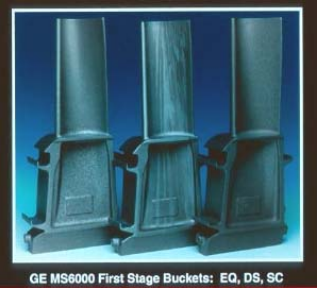ABSTRACT
Ni-base superalloy cast materials provide an outstanding balance of high temperature strength, fatigue resistance, oxidation resistance and coating performance and can be produced to very tight tolerances in extremely complex configurations, such as axial and centrifugal integral cast turbine wheels. As a result, cast superalloys are used in the most demanding applications of aero and industrial gas turbine engines. Use of these materials is expanding to smaller microturbine, turbojet, turbocharger and missile engine applications due to this unique combination of desirable properties. This paper will present an overview of the application of investment cast Ni-base superalloys and process capability to small turbine and missile engines.
INTRODUCTION
Nickel-base superalloy materials have extensive application in the hot turbine section of aero and industrial gas turbine engines. Traditionally, hot section gas turbine alloy development starts with engine requirements that cannot be met by existing alloys, e.g., higher temperature, strength, or durability requirements. Cast Ni-base superalloys provide a unique combination of characteristics suitable to these requirements, which are also applicable to small turbine and missile engines.
The superalloys encompass a group of alloys, based on nickel, iron or cobalt, which are utilized structurally at operating temperatures of 538°C (1000°F) or higher. Superalloys exhibit superior elevated temperature properties and are used in applications involving the hottest temperatures and/or highest stresses in the gas turbine, most notably turbine blades (or buckets), vanes (or nozzles), integral wheels, discs and combustion chamber components. In addition to maintaining high strength at operating temperatures approaching 85% of melting point, these materials exhibit good hot corrosion and oxidation resistance required in the gas turbine environment. Also, superalloys can be economically cast into components of complex shapes and/or internal configurations with controlled uniform microstructure.
Superalloys were first introduced into military gas turbine engines during World War II, and the technology has advanced dramatically since that time. Continual incremental materials advances have been introduced with casting process developments and optimized alloys “hop-scotching” one another to advance the overall material capability. These advances include conventionally cast, equiax (EQ) alloys, directionally solidified (DS) and single crystal (SX) cast components. This paper will discuss the characteristics and applications of each casting technology, along with examples of alloys and properties.
CASTING PROCESS DEVELOPMENT

Figure 1. Casting Technology Progression
The initial applications of cast superalloy turbine blades and vanes were conventional cast, equiax (EQ) alloys. Equiax castings are used in the majority of applications including static and rotating parts, integral wheels and structural components. Property requirements include high temperature creep and fatigue strength, ductility and weldability for both fabrication and repair.
The introduction of directional solidification produced castings with columnar grains parallel to the high stress loading direction of rotating parts (Figure 1)[1]. These castings realized significant gains in creep-rupture strength and LCF life due to the elimination of grain boundaries transverse to the high stress loading axis and reduced microporosity resulting from the slow moving solidification front inherent in DS technology. DS alloys are typically specified for rotating part applications, such as 2nd and 3rd stage turbine blades, where EQ alloys do not provide adequate creep strength.
A further extension of DS casting technology was the introduction of single crystal processes, pioneered by Pratt & Whitney Aircraft [2] which eliminated all grain boundaries and consequently, the need for grain boundary strengthening elements, such as C, B, Hf and Zr. Since these elements are melting point depressants, the temperature capability of SX alloys was significantly improved. Single crystal alloys are used in the most demanding high stress/ high temperature engine applications such as 1st stage turbine blades and vanes and combustor components. The benefits of SX castings include improved creeprupture, fatigue, oxidation and coating properties, resulting in superior turbine engine performance and durability [2-6]. In addition, single crystal alloys retain a higher fraction of their thick section rupture life as wall thickness is reduced (Figure 2) [7].
 Figure 2. Rupture life vs. specimen thickness showing benefit of SX castings over DS/EQ
Figure 2. Rupture life vs. specimen thickness showing benefit of SX castings over DS/EQ
ADVANCED SUPERALLOY MATERIALS
Advanced superalloy materials have been introduced to respond to industry needs for improved alloy properties. Equiax alloys CM 939 Weldable®, CM 247 LC® and CM 681 LC®, DS alloys CM 247 LC and CM 186 LC® and SX alloy CMSX-4® are representative of these improvements.
CM 939 Weldable® Alloy
IN 939 alloy (Table 1 [8]) was developed in the late 1960s by the International Nickel Company. This 22% chromium (Cr), hot corrosion resistant alloy has seen wide application in the industrial gas turbine (IGT) market for equiaxed vanes, segments and burner nozzles. However, IN 939 castings are difficult to weld repair due to marginal ductility and associated alloy chemistry design.

As a result of these difficulties, Cannon-Muskegon developed a modified version of IN 939 alloy for improved repair weldability and mechanical properties, with emphasis on alloy ductility. An optimized aim chemistry was devised with significantly reduced Al, Ti, Ta and Cb (and consequently, lower volume fraction gamma prime phase) compared to standard IN 939, optimized B, Zr and C content and dramatically improved alloy purity for S, P, N, O and Si. This proprietary composition was designated CM 939 Weldable alloy.

